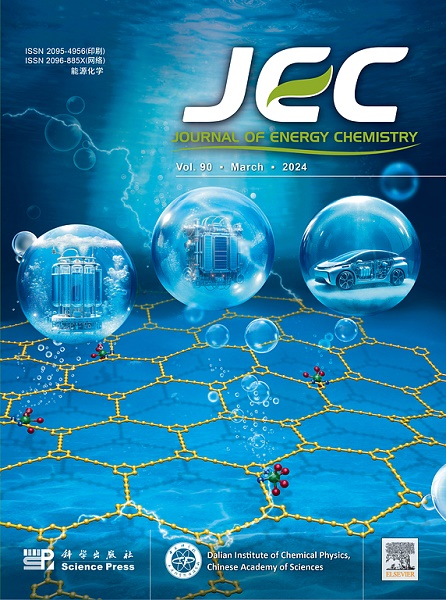IF 13.1
1区 化学
Q1 Energy
引用次数: 0
摘要
氨是现代农业的基石,为全球粮食生产提供了重要的氮源,也是众多工业化学品的关键原料。电催化硝酸盐还原法作为一种环境友好型合成氨方法,不仅可减轻当前氨合成工艺对传统化石燃料的依赖,还能有效减少农业和工业活动造成的硝酸盐污染。本综述探讨了电催化硝酸盐还原的基本原理,重点是电子转移和氨形成的关键步骤。此外,它还总结了影响反应性能和选择性的关键因素,包括电解质的特性、工作电压、电极材料和电解槽的设计。报告还进一步讨论了电催化剂的最新进展,包括纯金属催化剂、金属氧化物催化剂、非金属催化剂和复合催化剂,强调了它们在提高电催化硝酸酯制氨(NRA)反应的效率和选择性方面的重要作用。概述了工业 NRA 试验面临的关键挑战和进一步展望,以推动这一战略在现实世界中的应用。总之,本综述深入概述并全面介绍了电催化硝酸酯制氨技术,从而推动了该领域的进一步发展和创新。本文章由计算机程序翻译,如有差异,请以英文原文为准。

Sustainable ammonia synthesis: opportunities for electrocatalytic nitrate reduction
Ammonia is the cornerstone of modern agriculture, providing a critical nitrogen source for global food production and serving as a key raw material for numerous industrial chemicals. Electrocatalytic nitrate reduction, as an environmentally friendly method for synthesizing ammonia, not only mitigates the reliance on current ammonia synthesis processes fed by traditional fossil fuels but also effectively reduces nitrate pollution resulting from agricultural and industrial activities. This review explores the fundamental principles of electrocatalytic nitrate reduction, focusing on the key steps of electron transfer and ammonia formation. Additionally, it summarizes the critical factors influencing the performance and selectivity of the reaction, including the properties of the electrolyte, operating voltage, electrode materials, and design of the electrolytic cell. Further discussion of recent advances in electrocatalysts, including pure metal catalysts, metal oxide catalysts, non-metallic catalysts, and composite catalysts, highlights their significant roles in enhancing both the efficiency and selectivity of electrocatalytic nitrate to ammonia (NRA) reactions. Critical challenges for the industrial NRA trials and further outlooks are outlined to propel this strategy toward real-world applications. Overall, the review provides an in-depth overview and comprehensive understanding of electrocatalytic NRA technology, thereby promoting further advancements and innovations in this domain.
求助全文
通过发布文献求助,成功后即可免费获取论文全文。
去求助
来源期刊

Journal of Energy Chemistry
CHEMISTRY, APPLIED-CHEMISTRY, PHYSICAL
CiteScore
19.10
自引率
8.40%
发文量
3631
审稿时长
15 days
期刊介绍:
The Journal of Energy Chemistry, the official publication of Science Press and the Dalian Institute of Chemical Physics, Chinese Academy of Sciences, serves as a platform for reporting creative research and innovative applications in energy chemistry. It mainly reports on creative researches and innovative applications of chemical conversions of fossil energy, carbon dioxide, electrochemical energy and hydrogen energy, as well as the conversions of biomass and solar energy related with chemical issues to promote academic exchanges in the field of energy chemistry and to accelerate the exploration, research and development of energy science and technologies.
This journal focuses on original research papers covering various topics within energy chemistry worldwide, including:
Optimized utilization of fossil energy
Hydrogen energy
Conversion and storage of electrochemical energy
Capture, storage, and chemical conversion of carbon dioxide
Materials and nanotechnologies for energy conversion and storage
Chemistry in biomass conversion
Chemistry in the utilization of solar energy
 求助内容:
求助内容: 应助结果提醒方式:
应助结果提醒方式:


